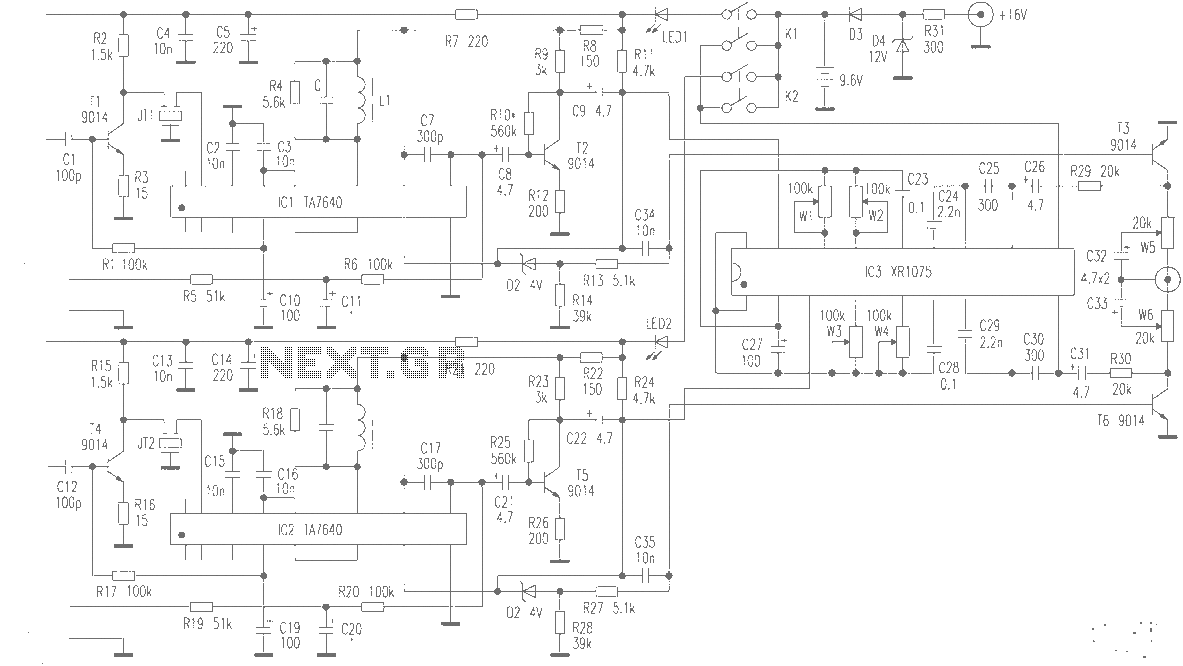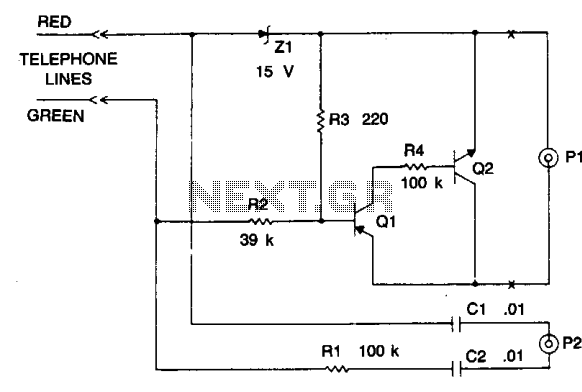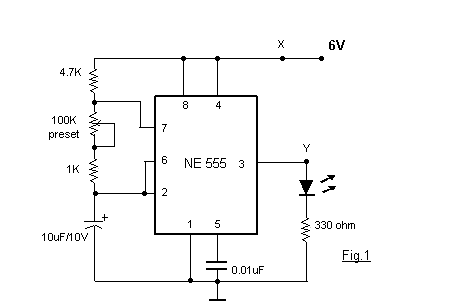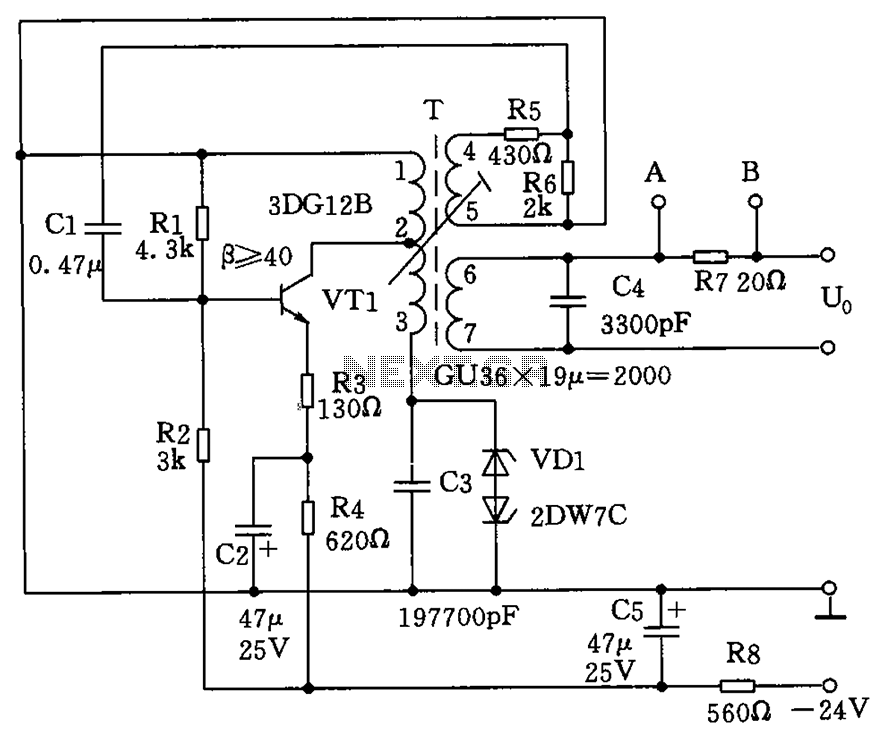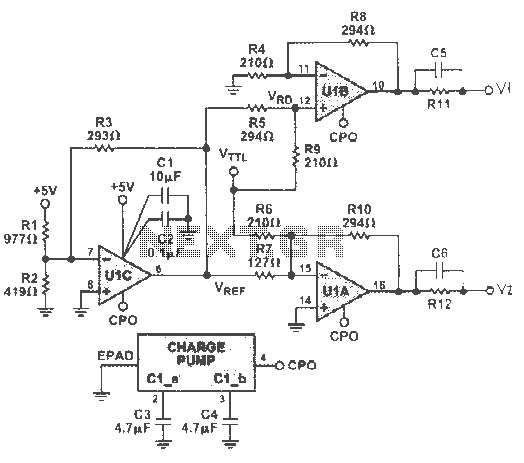
Water Activated Relay circuit board

The circuit diagram represents a water-activated relay circuit. This circuit employs two transistors configured as a high-gain compound pair. The transistors used are 2N2222A for T1 and T2, which may also be substituted with BC108. The current gain is determined by the product of each transistor's beta, which has a minimum value of 140 for T1 and 110 for T2, resulting in a total gain of 15,400. The power supply voltage can range from 4.5 to 15 volts, with a typical value being 5 volts. A standard relay may require 60 mA to operate, and in this scenario, any fluid flow that generates at least 4 microamperes (UA) will activate the relay. This activation can be easily achieved using tap water or rainwater. The following is a schematic drawing:
The water-activated relay circuit utilizes a simple yet effective design to control devices based on the presence of water. The primary components include two transistors, which serve as the core amplification elements. The first transistor (T1), a 2N2222A, is configured in a common-emitter arrangement, providing a significant voltage gain and enabling the circuit to respond to low currents generated by water flow. The second transistor (T2), also a 2N2222A or a BC108, operates in a similar manner, enhancing the overall current gain of the circuit.
The circuit is powered by a DC voltage supply, typically set at 5 volts for optimal performance. This voltage level is sufficient to drive the relay, which generally requires a current of 60 mA to engage its switching mechanism. The relay serves as the output device, allowing the circuit to control larger loads, such as lights or pumps, based on the water detection input.
The water detection mechanism relies on the conductivity of water, which allows a small current to flow through the circuit when water is present. This current is sufficient to bias the transistors into their active regions, enabling them to amplify the current and ultimately energize the relay coil. The threshold for activation is set at a minimum of 4 microamperes, which can be easily achieved with common sources of water, such as tap water or rainwater.
In summary, this water-activated relay circuit is a practical solution for applications requiring automatic control based on water presence. Its design leverages the high gain characteristics of the transistors to ensure reliable operation with minimal water flow, making it suitable for various environmental monitoring and automation tasks.Circuit diagram is water activated relay circuit. In this diagram circuit using two transistors connected as a high gain compound pair. 2N2222A transistors T1 and T2 may be a BC108. Current gain will be the product of each transistor beta, which will be a minimum of 140 x 110 or 15, 400. Power supply voltage can be used 4, 5-15 volts, a typical 5-vo lt relay may require 60 mA to operate, in this case any fluid flow through at least 4 UA will activate the relay. This is easily achieved with tap or rain water. The following is a schematic drawing: 🔗 External reference
The water-activated relay circuit utilizes a simple yet effective design to control devices based on the presence of water. The primary components include two transistors, which serve as the core amplification elements. The first transistor (T1), a 2N2222A, is configured in a common-emitter arrangement, providing a significant voltage gain and enabling the circuit to respond to low currents generated by water flow. The second transistor (T2), also a 2N2222A or a BC108, operates in a similar manner, enhancing the overall current gain of the circuit.
The circuit is powered by a DC voltage supply, typically set at 5 volts for optimal performance. This voltage level is sufficient to drive the relay, which generally requires a current of 60 mA to engage its switching mechanism. The relay serves as the output device, allowing the circuit to control larger loads, such as lights or pumps, based on the water detection input.
The water detection mechanism relies on the conductivity of water, which allows a small current to flow through the circuit when water is present. This current is sufficient to bias the transistors into their active regions, enabling them to amplify the current and ultimately energize the relay coil. The threshold for activation is set at a minimum of 4 microamperes, which can be easily achieved with common sources of water, such as tap water or rainwater.
In summary, this water-activated relay circuit is a practical solution for applications requiring automatic control based on water presence. Its design leverages the high gain characteristics of the transistors to ensure reliable operation with minimal water flow, making it suitable for various environmental monitoring and automation tasks.Circuit diagram is water activated relay circuit. In this diagram circuit using two transistors connected as a high gain compound pair. 2N2222A transistors T1 and T2 may be a BC108. Current gain will be the product of each transistor beta, which will be a minimum of 140 x 110 or 15, 400. Power supply voltage can be used 4, 5-15 volts, a typical 5-vo lt relay may require 60 mA to operate, in this case any fluid flow through at least 4 UA will activate the relay. This is easily achieved with tap or rain water. The following is a schematic drawing: 🔗 External reference
